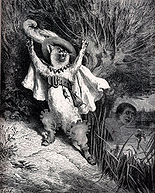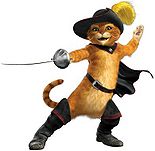Master Cat, or Puss in Boots (early French: Le Maistre Chat, ou Le Chat Botté, literally The Booted Cat) is a French literary fairy tale written at the close of the seventeenth century by Charles Perrault (1628–1703), about a cat who uses trickery and deceit to gain power, wealth, and the hand of a princess in marriage for his penniless and low-born master.
Story
The tale opens with the third and youngest son of a miller receiving his inheritance — a cat. At first, the youngest son laments, as the eldest brother gains the mill, and the middle brother attains the mules. The feline is no ordinary cat, however, but one who requests and receives a pair of boots. Determined to make his master's fortune, the cat bags a rabbit in the forest and presents it to the king as a gift from his master, the fictional Marquis of Carabas. The cat continues making gifts of game to the king for several months.
One day, knowing the king and his daughter are traveling by coach along the riverside, the cat persuades his master to remove his clothes and enter the river. The cat disposes of his master's clothing beneath a rock. As the royal coach nears, the cat begins calling for help in great distress, and, when the king stops to investigate, the cat tells him that his master, the Marquis, has been bathing in the river and robbed of his clothing. The king has the young man brought from the river, dressed in a splendid suit of clothes, and seated in the coach with his daughter, who falls in love with him at once.
The cat hurries ahead of the coach, ordering the country folk along the road to tell the king that the land belongs to the "Marquis of Carabas", saying that if they do not he will cut them into mincemeat. The cat then happens upon a castle inhabited by an ogre who is capable of transforming himself into a number of creatures. The ogre displays his ability by changing into a lion, frightening the cat, who then tricks the ogre into changing into a mouse. Once that change is complete, the cat pounces upon the mouse and devours it. The king arrives at the castle which formerly belonged to the ogre, and, impressed with the bogus Marquis and his estate, gives the lad the princess in marriage. Thereafter, the cat enjoys life as a great lord who runs after mice only for his own amusement.
The tale is followed immediately by two morals: "one stresses the importance of possessing industrie and savoir faire while the other extols the virtues of dress, countenance, and youth to win the heart of a princess.
Art/Fiction
- In 1797 German writer Ludwig Tieck published Der gestiefelte Kater, a dramatic satire based on the Puss in Boots tale.
- The Russian composer César Cui (of French ancestry) composed a short children's opera on this subject in 1913. Puss in Boots was first performed in Rome in 1915, and has been something of a repertory item in Germany since at least the 1970s.
- In 1922 Walt Disney created a black and white silent short of the same name.
- Hayao Miyazaki participated in the 1969 Toei Animation production of Nagagutsu wo Haita Neko (Puss 'n Boots), providing key animation, designs, storyboards, image boards, and story ideas. Its main character, the cat Pero, was very popular and eventually became Toei's mascot.
- The Master Cat by David Garnett is a novel first published in 1974 which gives a more detailed account of the established story from Puss getting the boots to his eating the ogre. The second part of the book tells of Puss getting caught up in palace plots and intrigues of which he ultimately becomes the victim, by his own ungrateful master no less.
- In 1985 the family television series Faerie Tale Theatre produced a live-action adaptation starring Ben Vereen as Puss and Gregory Hines as the miller's son.
- In an episode of Monty Python's Flying Circus, a sketch set in the Police Department of the State of Venezuela is interrupted by an unexpected adaptation of Puss in Boots.
- A live action direct-to-video film adaptation was made in 1988, starring Christopher Walken as Puss and Jason Connery as the miller's son.
- Enoki Films released a Japanese animated series called Nagagutsu wo Haita Neko no Bouken (Adventures of Puss-in-Boots) in 1992.
- Plaza Entertainment released an animated direct-to-video film called Puss in Boots in 1999.
- Puss in Boots appears as a character in the films Shrek 2 and Shrek 3 (voiced by Antonio Banderas). The character is originally recruited as a professional ogre killer but later becomes a sidekick to the ogre, Shrek - surprisingly, in the alternative world in Shrek Forever After due to Rumpelstiltskin erasing the day Shrek was born when he made him sign a contract, Puss is seen to have retired from fencing and he became Fiona's pet; he has also become huge and obese.
- In the furry comic book, Xanadu, the main male hero, Tabbe Le Fauve, is a cat modeled on Puss in Boots with a strong influence of Errol Flynn's typical swashbuckler character.
- A Meowth from the Pokémon anime series dresses up like Puss In Boots.
- In Gainax's 2000 anime FLCL, the third episode is named Maru Raba (Marquis de Carabas).
'* In The League of Extraordinary Gentlemen, Volume II, he is one of Dr. Moreau's creations.
- In Neil Gaiman's novel Neverwhere, the Marquis de Carabas appears as a character and is merged with Puss.
- The novel Reserved for the Cat by Mercedes Lackey is a retelling of Puss In Boots, set in her Elemental Masters series.
- In the manga, MÄR Puss 'n' Boots becomes a form of Babbo in the final battle against the main antagonist, Phantom.
- Puss in Boots is the fourth episode of the episode game series American McGee's Grimm, which features the dark version of the cat missing an eye.
'* La Véritable histoire du Chat botté is an animated French film (2009) of Jérôme Deschamps, Pascal Hérold and Macha Makeïeff.
- Puss in Boots appears in the Fables spin-off Cinderella: From Fabletown with Love. He is one of the animal Fables who has to live on Fabletown's "Farm."
'* Mary Hanson Roberts wrote and drew a long serial in the Furrlough anthropomorphic comic book, about the descendants of Puss in Boots and their adventures in their world's equivalent of the France of Louis XVI and the French Revolution, called "Here Comes a Candle." )
- Adam Ant's 1983 single "Puss 'n Boots".
In films
- Puss in Boots (1922 film), an American animated short directed by Walt Disney
- Puss in Boots (1934 film), an American animated short directed by Ub Iwerks
- Puss in Boots (1936 film), a German animated short directed by Lotte Reiniger
- Puss in Boots (1954 film), an English animated short directed by Lotte Reiniger and Carl Koch
- Puss in Boots (1969 film), a 1969 Japanese anime feature directed by Kimio Yabuki
- Puss in Boots (1982 film), an American film directed by John Clark Donahue and John Driver
- Puss in Boots (1988 film), a 93-minute musical directed by Eugene Marner starring Christopher Walken as "Puss"
- Puss in Boots (1999 film), an American animated feature directed by Phil Nibbelink
- Puss in Boots (Shrek), a character introduced in the 2004 movie sequel, Shrek 2
- The True Story of Puss'n Boots (2009 film), an 80-minute French animation
- Puss in Boots, an animated feature by DreamWorks Animation


